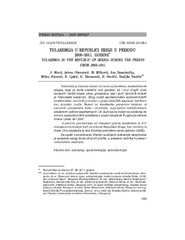Приказ основних података о документу
Tularemia in the Republic of Serbia during the period from 2000-2011
Tularemija u Republici Srbiji u periodu 2000-2011. godine
| dc.creator | Marić, Jovan | |
| dc.creator | Obrenović, Jelena | |
| dc.creator | Milković, Miodrag | |
| dc.creator | Samokovlija, Ana | |
| dc.creator | Elezović, Milica | |
| dc.creator | Ljubić, Božidar | |
| dc.creator | Stevanović, Goran | |
| dc.creator | Đuričić, Đorđe | |
| dc.creator | Đuričić, Bosiljka | |
| dc.date.accessioned | 2020-06-03T13:33:01Z | |
| dc.date.available | 2020-06-03T13:33:01Z | |
| dc.date.issued | 2012 | |
| dc.identifier.issn | 0350-2457 | |
| dc.identifier.uri | https://vet-erinar.vet.bg.ac.rs/handle/123456789/875 | |
| dc.description.abstract | Tularemia is an infective disease of zoonotic character, bacterial etiology, which occurs predominantly among rodents, but also in other species of domestic and wild mammals, birds, reptiles, fish, and humans. The cause of the disease is Francisella tularensis. Due to its epidemiological-epizootiological characteristics, the cause belongs to the group of biological agents and it has been used as a biological weapon. The disease is characterized by primary local ulcerous changes on the skin and mucosa, regional lymphadenitis, expressed general septicemia, and other changes. This disease is suspected on the grounds of epizootiological data on the incidence of the disease or the deaths of rabbits, sheep, or dogs, but also humans. During the observed period of twelve years, 317 cases of infected humans were recorded in the territory of the Republic of Serbia, without any mortal outcomes. The disease was confirmed in animals in only one case (2006.). In order to ensure full success in preventing the spreading and in the curbing of tularemia it is necessary to secure cooperation among a large number of professionals, in particular those engaged in the fields of human and veterinary medicine. | en |
| dc.description.abstract | Tularemija je zarazna bolest zoonoznog karaktera, bakterijske etiologije, koja se javlja pretežno kod glodara, ali i kod drugih vrsta domaćih i divljih sisara, ptica, gmizavaca, riba i ljudi. Uzročnik bolesti je Francisella tularensis. Zbog svojih epidemiološko epizootioloških karakteristika uzročnik je svrstan u grupu bioloških agenasa i korišćen kao biološko oružje. Bolest se karakteriše primarnim lokalnim ulceroznim promenama kože i sluzokože, regionalnim limfadenitisom, izraženom opštom septikemijom i dr. Sumnja na bolest se postavlja na osnovu epizootioloških podataka o pojavi oboljenja ili uginuća zečeva, ovaca i pasa, ali i ljudi. U periodu posmatranja od dvanaest godina zabeleženo je 317 slučajeva obolevanja ljudi na teritoriji Republike Srbije, bez smrtnog ishoda. Ovo oboljenje je kod životinja potvrđeno samo jednom (2006). Za uspeh u sprečavanju širenja i suzbijanju tularemije neophodna je saradnja većeg broja stručnih profila, a posebno radnika humane i veterinarske medicine. | sr |
| dc.publisher | Univerzitet u Beogradu - Fakultet veterinarske medicine, Beograd | |
| dc.rights | openAccess | |
| dc.rights.uri | https://creativecommons.org/licenses/by/4.0/ | |
| dc.source | Veterinarski Glasnik | |
| dc.subject | tularemia | en |
| dc.subject | epidemiology | en |
| dc.subject | epizootiology | en |
| dc.subject | tularemija | sr |
| dc.subject | epidemiologija | sr |
| dc.subject | epizootiologija | sr |
| dc.title | Tularemia in the Republic of Serbia during the period from 2000-2011 | en |
| dc.title | Tularemija u Republici Srbiji u periodu 2000-2011. godine | sr |
| dc.type | article | |
| dc.rights.license | BY | |
| dcterms.abstract | Ђуричић, Босиљка; Ђуричић, Ђорђе; Обреновић, Јелена; Милковић, Миодраг; Елезовић, Милица; Љубић, Божидар; Марић, Јован; Стевановић, Горан; Самоковлија, Aна; Туларемија у Републици Србији у периоду 2000-2011. године; Туларемија у Републици Србији у периоду 2000-2011. године; | |
| dc.citation.volume | 66 | |
| dc.citation.issue | 5-6 | |
| dc.citation.spage | 463 | |
| dc.citation.epage | 472 | |
| dc.citation.other | 66(5-6): 463-472 | |
| dc.citation.rank | M24 | |
| dc.identifier.doi | 10.2298/VETGL1206463M | |
| dc.identifier.fulltext | https://vet-erinar.vet.bg.ac.rs/bitstream/id/1404/874.pdf | |
| dc.type.version | publishedVersion |

